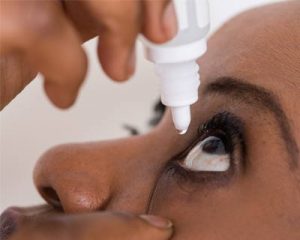Low humidity, wind (sleeping with a fan or sleep apnea mask), allergens and smoke are environmental factors that can cause problems with your tears.
Low humidity indoors is usually caused by extremes of temperatures outdoors. Even with a humidifier, we typically run heat or air conditioning more in extreme conditions, causing our knuckles to split, lips to crack and eyes to sting and burn. Other low-humidity environments include airplanes and large buildings, such as shopping malls, office buildings and hospitals.
Sleep apnea masks are common offenders, even if they fit well. Even a small amount of air leaking from a mask can dry the eyes through the tiny space between your eyelids. Allergens and smoke also cause tears to evaporate more quickly.
Drugs that often cause dry eye include:
- sedatives like Benadryl, sleep aids, cold remedies or anxiety pills
- allergy pills
- blood pressure medications
- medicated eye drops like glaucoma drops, Visine, Similasan or other drops with preservatives in them
Your ophthalmologist can help you identify medicines that could be causing your symptoms.
Health conditions that can cause dry eye include:
- diabetes
- thyroid dysfunction
- rheumatoid arthritis
- Parkinson’s disease
- rosacea
- previous eye surgery
Finally, any visually intensive task such as reading a book, staring at a computer or watching TV causes you to blink less often. Blinking less leads to eye strain and dry eyes.
There are things you can do to help with dry eye:
- For every hour of reading or watching TV, take a break and look away from the screen for at least 20 seconds. Blink frequently and consider using lubricant eye drops like Refresh, Systane, Soothe or Blink. Avoid any eye drops with a redness reliever or allergy component like Visine, Similasan or Naphcon A.
- If you must sleep with a fan on or other moving air, use a gel drop or eye ointment. These treatments will help keep your eyes moist overnight.
- Add walnuts and fish such as salmon to your diet. Both contain omega-3 fatty acids that help make the oily tear layer more like oil instead of shortening. The more fluid the layer is, the better it spreads across the top of the tears, preventing evaporation. If you are allergic to nuts or don’t love fish, try a fish oil supplement instead.
- If symptoms persist, see an ophthalmologist. Ophthalmologists are doctors trained to medically and surgically treat eye disease. They will perform a full medical history and comprehensive eye exam to determine all the contributing factors to dry eye syndrome and will prescribe treatment.
- Be patient with your body. Dry eye cannot be cured like pink eye with a course of antibiotic drops. It is a chronic condition requiring lifestyle changes and often medical treatment to maintain the best possible eye condition.




